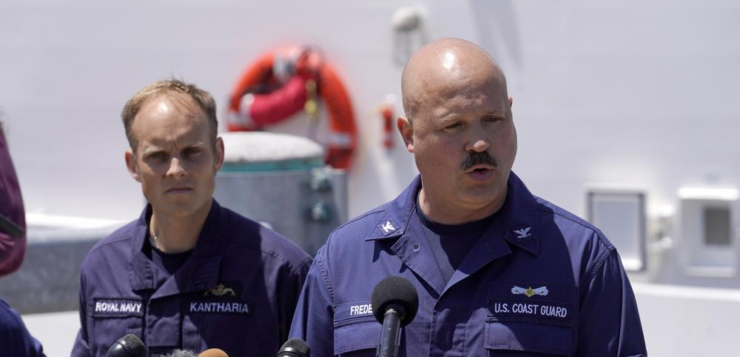By PATRICK WHITTLE and HOLLY RAMER
A submersible carrying five people to the Titanic imploded near the site of the shipwreck and killed everyone on board, authorities said Thursday, bringing a tragic end to a saga that included an urgent around-the-clock search and a worldwide vigil for the missing vessel.
Coast Guard officials said during a news conference that they’ve notified the families of the crew of the Titan, which has been missing since Sunday.
The sliver of hope that remained for finding the crew alive was wiped away early Thursday, when the submersible’s 96-hour supply of oxygen was expected to run out and the Coast Guard announced that a debris field had been found roughly 1,600 feet (488 meters ) from the Titanic.
The Coast Guard said the submersible likely imploded in the North Atlantic waters.
“The debris is consistent with the catastrophic loss of the pressure chamber,” said Rear Adm. John Mauger, of the First Coast Guard District.
OceanGate Expeditions, the company that owned and operated the submersible, said in a statement that all five people in the vessel, including CEO Stockton Rush, “have sadly been lost.”
The others on board were: two members of a prominent Pakistani family, Shahzada Dawood and his son Suleman Dawood; British adventurer Hamish Harding; and Titanic expert Paul-Henri Nargeolet.
“These men were true explorers who shared a distinct spirit of adventure, and a deep passion for exploring and protecting the world’s oceans,” OceanGate said in a statement. “We grieve the loss of life and joy they brought to everyone they knew.”
OceanGate has been chronicling the Titanic’s decay and the underwater ecosystem around it via yearly voyages since 2021.
Rescuers rushed ships, planes and other equipment to the site of the disappearance.
Authorities were hoping underwater sounds detected Tuesday and Wednesday might help narrow their search, whose coverage area had been expanded to thousands of miles — twice the size of Connecticut and in waters 2 1/2 miles (4 kilometers) deep.
But the Coast Guard indicated Thursday that the sounds were likely generated by something other than the Titan.
“There doesn’t appear to be any connection between the noises and the location (of the debris) on the seafloor,” Mauger said.
The Coast Guard will continue searching near the Titanic for more clues about what happened to the Titan. Efforts to recover the submersible and the remains of the five men who died will also continue, Mauger said.
The Titan launched at 6 a.m. Sunday and was reported overdue Sunday afternoon about 435 miles (700 kilometers) south of St. John’s, Newfoundland, as it was on its way to where the iconic ocean liner sank more than a century ago. By Thursday, when the oxygen supply was expected to run out, there was little hope of finding the crew alive.
Broadcasters around the world started newscasts at the critical hour Thursday with news of the submersible. The Saudi-owned satellite channel Al Arabiya showed a clock on air counting down to their estimate of when the air could potentially run out.
At least 46 people successfully traveled on OceanGate’s submersible to the Titanic wreck site in 2021 and 2022, according to letters the company filed with a U.S. District Court in Norfolk, Virginia, that oversees matters involving the Titanic shipwreck. But questions about the submersible’s safety were raised by former passengers.
One of the company’s first customers likened a dive he made to the site two years ago to a suicide mission.
“Imagine a metal tube a few meters long with a sheet of metal for a floor. You can’t stand. You can’t kneel. Everyone is sitting close to or on top of each other,” said Arthur Loibl, a retired businessman and adventurer from Germany. “You can’t be claustrophobic.”

During the 2 1/2-hour descent and ascent, the lights were turned off to conserve energy, he said, with the only illumination coming from a fluorescent glow stick.
The dive was repeatedly delayed to fix a problem with the battery and the balancing weights. In total, the voyage took 10 1/2 hours.
The submersible had seven backup systems to return to the surface, including sandbags and lead pipes that drop off and an inflatable balloon.
Nicolai Roterman, a deep-sea ecologist and lecturer in marine biology at the University of Portsmouth, England, said the disappearance of the Titan highlights the dangers and unknowns of deep-sea tourism.
“Even the most reliable technology can fail, and therefore accidents will happen. With the growth in deep-sea tourism, we must expect more incidents like this.”
Associated Press writers Jon Gambrell in Dubai, United Arab Emirates; Ben Finley in Norfolk, Virginia; Frank Jordans in Berlin; Danica Kirka in London; and John Leicester in Paris contributed to this report.





